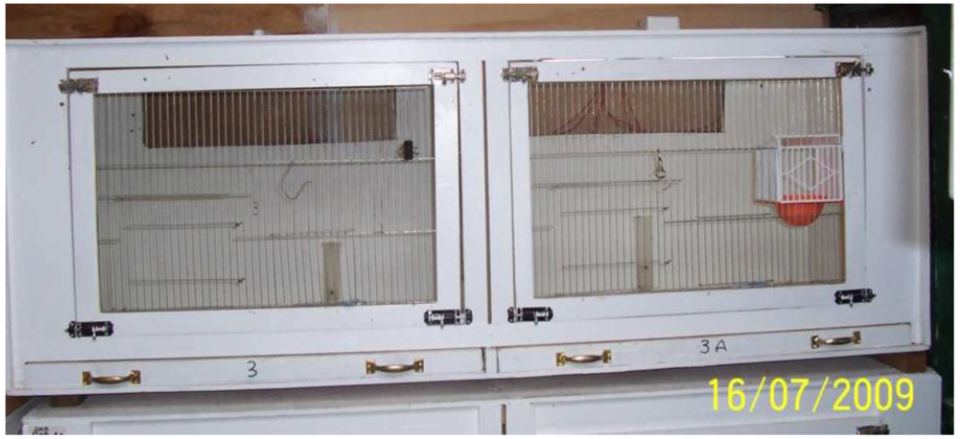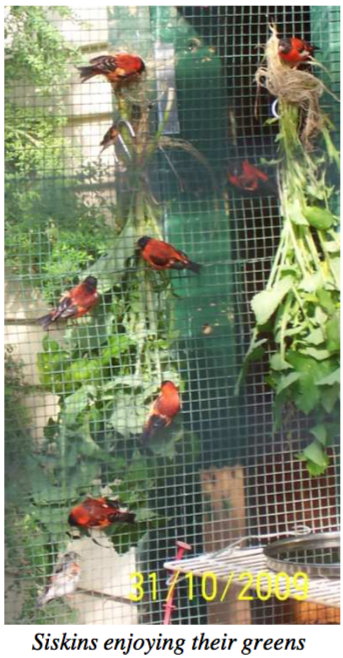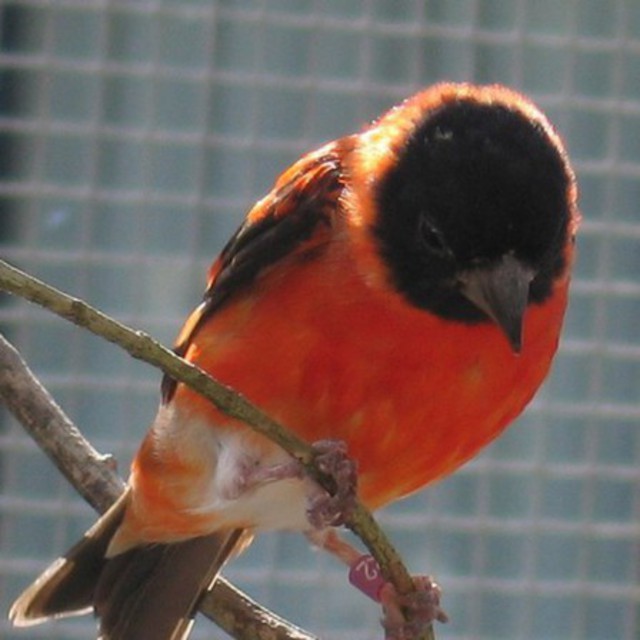The Red Siskin - Article: Breeding the Red Siskin by Bruce Brownlee
Breeding the Red Siskin.
By Bruce Brownlee
Breeding this the most shamefully abused bird in aviculture has assumed the urgency which we call extinction. Now so rare in their Venezuelan homeland , they are number one on Cites - The Convention on Trade in Endangered Species.
So many of us keep this wonderful songster in unsuitable mixed ,drafty aviaries, we hybridise it, feed it food it abhors and wonder why it will not breed let alone survive. Let me share my thoughts and experience with you.
This bird is a Goldfinch Carduelis cucullata. Carduelis placing him in the genus Cardueline (goldfinches etc) cucullata meaning hooded - the hooded (but red) goldfinch. He is passerine meaning a perching bird and is classified as Fringilidia meaning a cup shaped nest builder.
Because of our fluctuating cold, nocturnal temperatures this tropical bird needs to be bred under tightly controlled conditions. A small breeding aviary is suitable but a large double compartment breeding cage is superb. Such a cage should allow the bids privacy so that they feel secure and unthreatened. Pairs are best but a three compartment cage with the cock in the middle compartment will work too. The cock of course has to be let through in order to fertilise the hen (s).
I separate my hens from the cocks in aviaries “out of season” placing the hen in late winter in the breeding cage. Here she has a nest which I start but do not finish. I place nesting material (a mixture of sisal and coconut fibre) where she can get at it. When she starts to build her nest only then do I introduce the cock. Prior to this he has been lustfully ‘eying his intended’ from his side of the breeding cage. Depending on his degree of frustration mating will take place immediately.
Perching. A variety of thicknesses or branches is important. If inadequate or not high enough it will make for poor mating. Even worse our bird will sleep on the wire – and lose a foot to marauding rats/cats. The passerine hind claw locks according to the depth of sleep.
Lighting. This is very important. The quality (daylight value) as well as the period length need to be considered as they effect both hormones and the early and late feeding of young. So we have the necessity of gradually extending the length of the day to about sixteen hours. Anything less means starving babies. Of course a dimmer is essential. Did you notice the word gradually ?
Food. Alas, this is not easy! This bird is mainly an oil seed eater but dislikes linseed. His main food Niger ( Guizotia abyssinica ) is destroyed under the guise of biosecurity by

Double compartment breeding cage
Gamma radiation, to quote MAF “to the point of non viability”. Therefore this, the most expensive of all seed is a sham. It is dead. Dead seed is not a seed at all. It does not have the germ of life. Even worse it has no nutritional value. I compensate for this as much as possible by soaking hulled sunflower, sprouting both canary and rape seed. The short growing tip of the sprout has the most nutritional value according to its length. If the sprout becomes too long it is just greens – but that too has value. It is also good practise to put some hulled sunflower through a coffee grinder and add a little Safflower oil – but not too oily. The bird will pick desultorily at various millets and can dehusk the small seed ornamental sunflower. Grow the latter in pots. Green seeds such as canary, twitch etc are important and are preferred to commercial seed. Blue Maw is a necessary adjunct. It contains all twenty amino acids – the building blocks of protein. If these seeds are New Zealand grown you also can do likewise. Egg food is important and is fed to the young complete with shell.
Calcium. Crushed cuttlebone, liquid calcium with vitamin D3 (in small silos) and general vitamin supplementation will prevent egg binding. If there is insufficient D3, the calcium will not be absorbed although sunlight will convert the birds own ergosterol into vitamin D.
Greens. The bird eats the whole dandelion plant, root and all. They also love the seed of it which is easily grown. Shepherds purse, cress and many other greens are necessary to bring the bird into breeding condition.
Fruit. A daily thin slice of apple clipped to the front of the cage is relished.
Tuberculosis. Avian tuberculosis is (in New Zealand) an untreatable disease. Unfortunately the Red Siskin is considered to be at the top end of the risk factor. Is it any wonder. Feeding the bird properly is made unnecessarily difficult.
Nesting. The incubation period is twelve days. Remove the eggs as they are laid and replace them with a fake egg. Place them with great care pointed end down in soft sand or sawdust and reverse them daily. When the third egg is laid replace them removing the fakes. If the eggs are fertile they will all hatch on the same day. The advantage being that all will be treated fairly. The first born (the strongest) will not be able to hog all the food. Nesting. When the young arrive at twelve or so days, the hen seems reluctant to leave an unhatched egg. Consequently, those that have hatched might not get fed. Get rid of that egg as soon as you realise it is a dud.
The hen will always leave her still naked young on or about the fourth night. If some means of heating the nest is not found, they will not survive the night. I have tried different methods including a sixty watt incandescent light bulb, adjusted for heat distance to nest. However the light does tend to upset the birds. It is also a potential fire risk being underneath the nest (from extraneous material deposits). At present I am using a seventeen watt Dampchaser which is not quite powerful enough. I suspect an underfloor heating wire coil or circulating hot water would be better.
Fledging. The young emerge from the nest on the seventeenth day. The hen continues to feed but will soon start another clutch. The cock will then assume full responsibility for his youngsters.

Breeding cages. These are best if they are box type, have privacy, firm perches, good lighting, through flow ventilation, two doors and underneath a deep pull out tray - the same width as your daily newspaper. That is important. One sheet removed a day makes cleaning a breeze - if you do not clutter up the cage floor.
Let us remember the red Siskin is a tropical bird. It is not hard to breed but is a challenge to raise to maturity. The adult is relatively hardy - but its babies are not. Having said that cold winds especially if damp, will kill adults quite quickly. Tropical birds do not “toughen up”. They die instead.
Sixty eight years ago I bred Diamond Firetails and Bicheno Finches. A friend of the same age bred strawberry finches. Workaday life makes for difficult times and we gave them up always intending to return. Alas! When that time came those birds were no more. If we are to continue to call ourselves breeders we need to work harder and breed, breed, breed what little we have left.
Competing with the playstation and not using the computer to its full potential along with infill housing means that bird breeding is in dangerous decline - an old persons hobby. We need to rectify that by encouraging our own youngsters. “Hey Dad, build me an aviary”.
The red siskin is a bird that will fill you with happiness and on dark days the blackest despair. The hens also sing . Not the glorious song of the cock but a pleasant interesting group chatter.
Footnote 1: The splendid husked Sunflower Seed you buy from your supermarket is grown overseas, but has been certified as fit for human consumption. Certification of seed raises the cost. Most imported birdseed is marked “not for human consumption”. NZ gown Sunflower is just as good but our seed merchants will not dehusk it. As bird lovers we consumers are scorned.
MAF’s Website: http:// www.biosecurity.govt.nz/imports/ plants/standards/bnz-gcfp-phr.htm is an interesting site worth visiting.
Footnote 2: Some Birdseed/millets go into bread etc. It is certified seed.
Taken from Finches May 2010 Page 9


